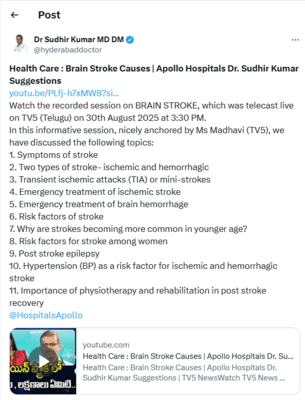We have long assumed that strokes were the domain of grandparents, retirement communities and “later-life” heart trouble but on World Stroke Day 2025 this Wednesday, it is important to note that this assumption is quietly putting younger adults and even millennials at risk. According to neurologist Dr Sudhir Kumar of Apollo Hospitals, the narrative is shifting fast. In a recent social media post on X (formerly Twitter), he dropped the warning message, “Stroke does not wait for age.”
The reality is that strokes are happening at younger ages as lifestyle trends are shifting risk profiles yet many of us still act like the wall belongs on the other side. The World Stroke Organization's 2025 global stroke fact sheet reported that globally one in four people over age 25 will have a stroke in their lifetime, underlining the importance of awareness and prevention across all adult age groups. Here’s how to translate the warning signs into practical habits.
Break the “older-person” stroke myth and why it holds you back
Dr Kumar emphasized that the belief “stroke is for old people” is dangerously outdated as “stroke can strike people in their 30s and 40s, especially with rising cases linked to lifestyle diseases .” In fact, major sources say that up to 80–90 % of strokes are preventable if we act early but when we assume “I’m too young,” we miss opportunities for prevention. Younger adults may skip check-ups, ignore rising blood pressure, continue smoking or sit long hours at a desk while believing stroke is a far-away possibility.

A recent systematic review published in 2025 in the Indian Journal of Medical Research reported stroke incidence rates in Indian urban centers between 105 to 152 per 100,000 persons annually, higher than those in many high-income countries. Prevalence varied widely, up to 559 per 100,000, with early stroke mortality rates in India also higher than in developed countries. A 2024 study published in Lancet Neurology highlighted a 51% increase in new stroke cases in India over 30 years, from 650,000 in 1990 to over 1.25 million in 2021.
It emphasized that more than 75% of stroke victims live in low- and middle-income countries, with environmental risk factors such as air pollution playing a greater role in these regions. The study also noted the rising burden of stroke in younger populations in India compared to high-income countries.
Recognise the stroke signs and take fast action)If awareness stops at “slurred speech” or “paralysis,” it is not enough. Dr Kumar asserted that even brief symptoms or “mini-strokes” or a Transient Ischemic Attack (TIA) are red flags and are not mild events you can wait out. He encouraged to remember: FAST (stands for Face drooping, Arm weakness, Speech difficulty, Time) to call emergency. Ignoring a fleeting FP (“felt odd for a minute then gone”) moment could delay treatment and make recovery harder. Dr Kumar stressed that a whopping 80 to 90 percent of strokes can be prevented with timely lifestyle changes and medical care. This means you have the power to reduce your risks dramatically.

One of the most crucial takeaways is learning to recognise stroke symptoms quickly. The acronym FAST can be a lifesaver:
Why lifestyle choices matter more than you realise
If young-adult strokes are on the rise, the culprits are unhealthy patterns, unchecked health markers and the “we’ll deal with it later” mindset. Here’s what experts insist to focus on:
Blood pressure and diabetes – Higher numbers quietly damage vessels. Regular screenings matter. Sedentary behaviour – Sitting long hours, skipping movement. Global office culture (Mumbai-to-London) plays a role. Diet, smoking, alcohol – Poor nutrition, excess alcohol and tobacco all raise risk. Sleep and stress – Chronic poor sleep, night shifts and high stress levels heighten risk. It is not just luck or genetics, it is the everyday choices. Whether you are living in Dubai’s high-rise, London’s flat, Toronto suburb or Melbourne’s CBD, the following apply:
Move every hour – Even a 5-minute walk or light stretch can reset circulation. Eat smart – Focus on whole grains, legumes, fresh produce, fewer processed foods. Check health markers – Blood pressure, sugar levels, cholesterol: get baseline data. Mind your breaks and sleep – No device-till-bed, prioritise 7–8 hours, avoid extreme shift patterns when possible. Don’t ignore weird symptoms – A sudden headache, flu-like dizziness, odd numbness: get checked. A new mindset for brain health
The takeaway is not fear-mongering, it is empowerment. The phrase “stroke is only for the elderly” belongs in medical history. Today’s brain health requires early mindset shifts of prevention now, not later; awareness that age is not an immunity card and the humility to recognise risk factors even if you feel invincible.
Dr Kumar reminds us, “Most strokes can be prevented” and in a world where we are living longer and older than ever, prevention becomes not just medical but lifestyle.
Note: The information provided in this article is for educational purposes only and is not intended as medical advice. Always consult with a healthcare professional before starting any new medication or treatment.
The reality is that strokes are happening at younger ages as lifestyle trends are shifting risk profiles yet many of us still act like the wall belongs on the other side. The World Stroke Organization's 2025 global stroke fact sheet reported that globally one in four people over age 25 will have a stroke in their lifetime, underlining the importance of awareness and prevention across all adult age groups. Here’s how to translate the warning signs into practical habits.
Break the “older-person” stroke myth and why it holds you back
Dr Kumar emphasized that the belief “stroke is for old people” is dangerously outdated as “stroke can strike people in their 30s and 40s, especially with rising cases linked to lifestyle diseases .” In fact, major sources say that up to 80–90 % of strokes are preventable if we act early but when we assume “I’m too young,” we miss opportunities for prevention. Younger adults may skip check-ups, ignore rising blood pressure, continue smoking or sit long hours at a desk while believing stroke is a far-away possibility.

A recent systematic review published in 2025 in the Indian Journal of Medical Research reported stroke incidence rates in Indian urban centers between 105 to 152 per 100,000 persons annually, higher than those in many high-income countries. Prevalence varied widely, up to 559 per 100,000, with early stroke mortality rates in India also higher than in developed countries. A 2024 study published in Lancet Neurology highlighted a 51% increase in new stroke cases in India over 30 years, from 650,000 in 1990 to over 1.25 million in 2021.
It emphasized that more than 75% of stroke victims live in low- and middle-income countries, with environmental risk factors such as air pollution playing a greater role in these regions. The study also noted the rising burden of stroke in younger populations in India compared to high-income countries.
Recognise the stroke signs and take fast action)If awareness stops at “slurred speech” or “paralysis,” it is not enough. Dr Kumar asserted that even brief symptoms or “mini-strokes” or a Transient Ischemic Attack (TIA) are red flags and are not mild events you can wait out. He encouraged to remember: FAST (stands for Face drooping, Arm weakness, Speech difficulty, Time) to call emergency. Ignoring a fleeting FP (“felt odd for a minute then gone”) moment could delay treatment and make recovery harder. Dr Kumar stressed that a whopping 80 to 90 percent of strokes can be prevented with timely lifestyle changes and medical care. This means you have the power to reduce your risks dramatically.

One of the most crucial takeaways is learning to recognise stroke symptoms quickly. The acronym FAST can be a lifesaver:
- Face drooping: Does one side of the face sag or numb?
- Arm weakness: Can the person raise both arms, or does one drift downward?
- Speech difficulty: Is speech slurred, strange, or hard to understand?
- Time to call emergency services: Every minute counts, so don’t hesitate.
Why lifestyle choices matter more than you realise
If young-adult strokes are on the rise, the culprits are unhealthy patterns, unchecked health markers and the “we’ll deal with it later” mindset. Here’s what experts insist to focus on:
The takeaway is not fear-mongering, it is empowerment. The phrase “stroke is only for the elderly” belongs in medical history. Today’s brain health requires early mindset shifts of prevention now, not later; awareness that age is not an immunity card and the humility to recognise risk factors even if you feel invincible.
Dr Kumar reminds us, “Most strokes can be prevented” and in a world where we are living longer and older than ever, prevention becomes not just medical but lifestyle.
Note: The information provided in this article is for educational purposes only and is not intended as medical advice. Always consult with a healthcare professional before starting any new medication or treatment.
You may also like

Tottenham boss Thomas Frank facing midfield dilemma after Newcastle injury blow

Rishab Shetty thanks his direction squad for 'standing strong' with him

Gold Silver Price Update: Gold Down ₹13,000 from Record High, Silver Falls ₹23,000 — What's Next for Investors?

Not even the US or EU: Why Mexico alone gets a 180-day multiple-entry Visit Visa in the UAE

Who is sending death threats and demanding jail time for TikTok star Kaz Sawyer after his Singapore pool video?






